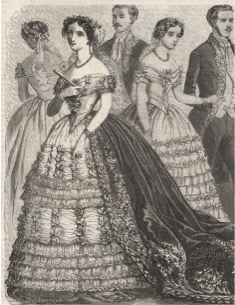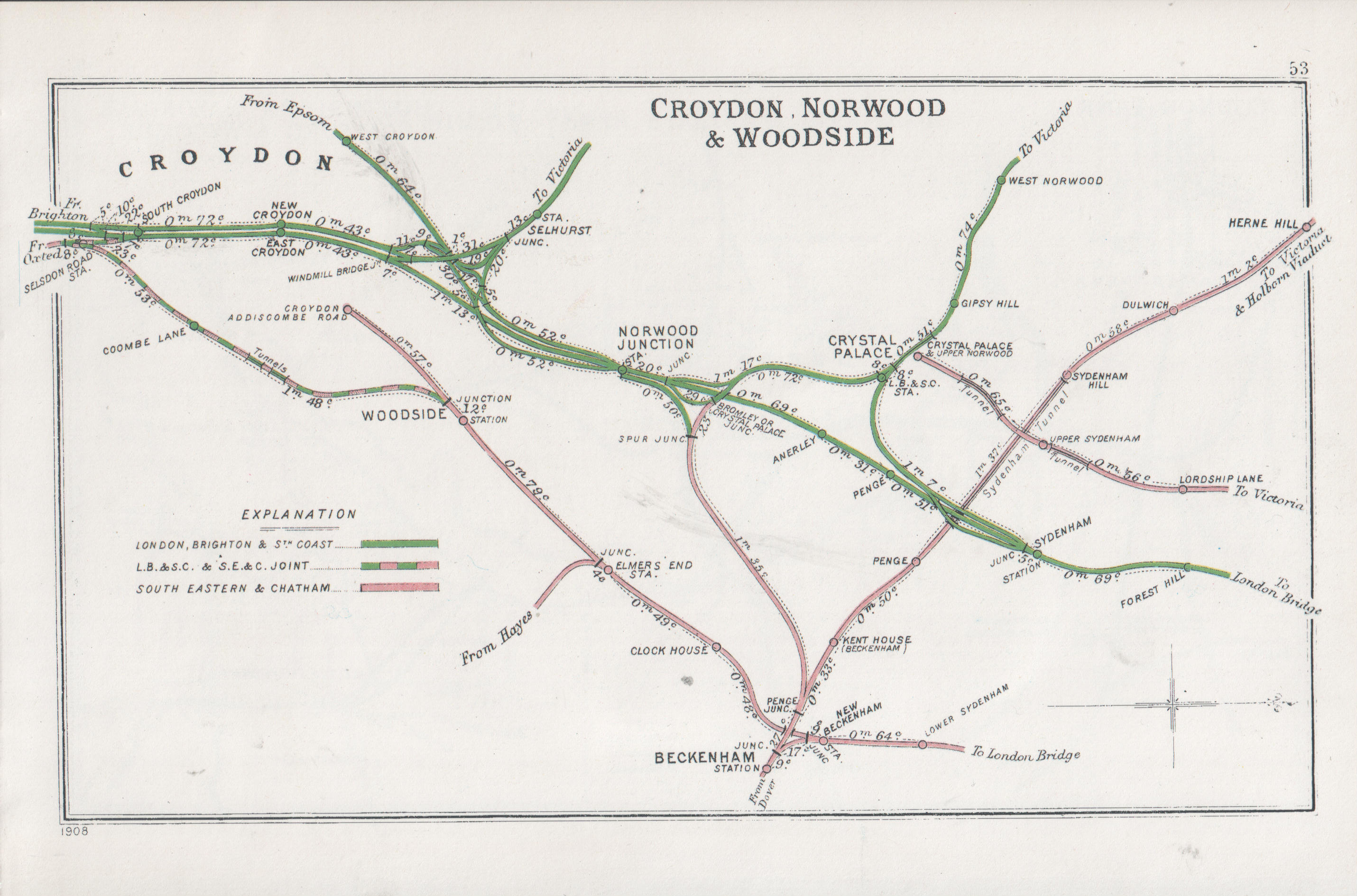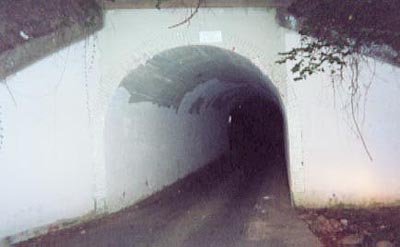|
Crystal Palace Pneumatic Railway
The Crystal Palace Pneumatic Railway was an experimental atmospheric railway that ran in Crystal Palace Park in south London in 1864. History The railway was designed by Thomas Webster Rammell, who had previously built a pneumatic railway for the London Pneumatic Despatch Company to convey letters along tunnels in large vacuum-driven wagons. A similar principle was applied to this railway, where a carriage fitted with a large collar of bristles was sucked along an airtight tunnel that measured .Hadfield, C. (1967) ''Atmospheric Railways: A Victorian Venture in Silent Speed'' Newton Abbot: David & Charles The bristle collar served to keep the tunnel "partially airtight". It operated for just over two months, and may have been a demonstration line for a more substantial atmospheric railway planned between Waterloo and Whitehall, construction of which was started under the Thames but never completed. The tunnel was built in a shallow trench of in depth; the contemporary illustr ... [...More Info...] [...Related Items...] OR: [Wikipedia] [Google] [Baidu] |
Waterloo And Whitehall Railway
The Waterloo and Whitehall Railway was a proposed and partly constructed 19th century Rammell pneumatic railway in central London intended to run under the River Thames just upstream from Hungerford Bridge, running from Waterloo station to the Whitehall end of Great Scotland Yard. The later Baker Street and Waterloo Railway followed a similar alignment for part of its route. Origins Authorised by the ''Waterloo and Whitehall Railway Act 1865'', its route was: A Railway commencing in the Parish of St Martin's-in-the-Fields in the County of Middlesex in the Street or Place known as Great Scotland Yard at or near the Western End thereof, and terminating in the Parish of Lambeth and County of Surrey in a Piece of Land belonging to the London and South-western Railway Company, and in the Occupation of Edwin Benjamin Gammon, near to and opposite the Arches under the Waterloo Station of that Railway numbered respectively 249 and 250. The period was extended by the ''Waterloo and ... [...More Info...] [...Related Items...] OR: [Wikipedia] [Google] [Baidu] |
Greater London Industrial Archaeology Society
The Greater London Industrial Archaeology Society (GLIAS) is the industrial archaeology society for the Greater London area. Origins and Responsibilities Founded in 1968 by individuals who had been involved in the Thames Valley Observation Group, it quickly established itself as the leading industrial archaeological and industrial history group in the London area. The society is a member of the South East Regional Industrial Archaeological Conference, the Association for Industrial Archaeology, and the TICCIH. It also works together with more locally directed history groups and projects supporting individual conservation projects, as well as raising industrial historical issues with national UK organisations such as English Heritage and the Royal Fine Art Commission. In addition it comments on planning applications and developments likely to have an effect on the preservation and survival of industrial structures. In this remit it acts as a statutory consultee. Its memb ... [...More Info...] [...Related Items...] OR: [Wikipedia] [Google] [Baidu] |
Crystal Palace, London
Crystal Palace is an area in south London, England, named after the Crystal Palace Exhibition building, which stood in the area from 1854 until it was destroyed by fire in 1936. Approximately south-east of Charing Cross, it includes one of the highest points in London, at , offering views over the capital. The area has no defined boundaries and straddles five London boroughs and three postal districts, although there is a Crystal Palace electoral ward and Crystal Palace Park in the London Borough of Bromley. It forms a part of the greater area known as Upper Norwood, and is contiguous with the areas of Anerley, Dulwich Wood, Gipsy Hill, Penge, South Norwood and Sydenham. Until development began in the 19th century, and before the arrival of the Crystal Palace, the area was known as Sydenham Hill. The Norwood Ridge and an historic oak tree were used to mark parish boundaries. The area is represented by three parliamentary constituencies, four London Assembly constituenci ... [...More Info...] [...Related Items...] OR: [Wikipedia] [Google] [Baidu] |
Closed Railway Lines In London
Closed may refer to: Mathematics * Closure (mathematics), a set, along with operations, for which applying those operations on members always results in a member of the set * Closed set, a set which contains all its limit points * Closed interval, an interval which includes its endpoints * Closed line segment, a line segment which includes its endpoints * Closed manifold, a compact manifold which has no boundary Other uses * Closed (poker), a betting round where no player will have the right to raise * ''Closed'' (album), a 2010 album by Bomb Factory * Closed GmbH, a German fashion brand * Closed class, in linguistics, a class of words or other entities which rarely changes See also * * Close (other) * Closed loop (other) * Closing (other) * Closure (other) * Open (other) Open or OPEN may refer to: Music * Open (band), Australian pop/rock band * The Open (band), English indie rock band * ''Open'' (Blues Image album), 1969 * ''Op ... [...More Info...] [...Related Items...] OR: [Wikipedia] [Google] [Baidu] |
Beach Pneumatic Transit
The Beach Pneumatic Transit was the first attempt to build an underground public transit system in New York City. It was developed by Alfred Ely Beach in 1869 as a demonstration subway line running on pneumatic power. The subway line had one stop in the basement of the Rogers Peet Building and a one-car shuttle going back and forth . It was not a regular mode of transportation, and lasted from 1870 until 1873. History Alfred Ely Beach demonstrated a model of basic pneumatic subway system, in which air pressure in the tube pushed the cars, at the American Institute Exhibition in New York in 1867. After demonstrating that the model was viable, in 1869 Beach and his Beach Pneumatic Transit Company began constructing a pneumatically powered subway line beneath Broadway. Funneled through a company he set up, Beach put up $350,000 of his own money to pay for the full-scale test project. [...More Info...] [...Related Items...] OR: [Wikipedia] [Google] [Baidu] |
Atmospheric Railway
An atmospheric railway uses differential air pressure to provide power for propulsion of a railway vehicle. A static power source can transmit motive power to the vehicle in this way, avoiding the necessity of carrying mobile power generating equipment. The air pressure, or partial vacuum (i.e., negative relative pressure) can be conveyed to the vehicle in a continuous pipe, where the vehicle carries a piston running in the tube. Some form of re-sealable slot is required to enable the piston to be attached to the vehicle. Alternatively the entire vehicle may act as the piston in a large tube or be coupled electromagnetically to the piston. Several variants of the principle were proposed in the early 19th century, and a number of practical forms were implemented, but all were overcome by unforeseen disadvantages and discontinued within a few years. A modern proprietary system has been developed and is in use for short-distance applications. Porto Alegre Metro airport connection ... [...More Info...] [...Related Items...] OR: [Wikipedia] [Google] [Baidu] |
Tom Brown (novelist)
Tom Brown may refer to: Sports American football *Tom Brown (tackle) (1890–1972), American football player * Tom Brown (end) (1921–2013), American football player in the NFL * Tom Brown (safety) (born 1940), American athlete who played football in the NFL and baseball in MLB * Tom Brown (wide receiver) (born 1963), American football player in the NFL * Tom Brown (running back) (born 1964), American football player in the NFL *Tom Brown (guard) (born 1936), American football player in the CFL Other sports * Tom Brown (outfielder) (1860–1927), American baseball player and manager * Tom Brown (bowls) (1915–1980), England lawn bowls competitor * Tom Brown (footballer, born 1919) (1919–2000), Scottish footballer *Tom Brown (tennis) (1922–2011), American tennis player *Tom Brown (pitcher) (born 1949), American baseball pitcher * Tom Brown (footballer, born 1968), Scottish former footballer * Tom Brown (rugby, born 1983), English rugby union and rugby league player * Tom Brown ... [...More Info...] [...Related Items...] OR: [Wikipedia] [Google] [Baidu] |
Fantasy
Fantasy is a genre of speculative fiction involving Magic (supernatural), magical elements, typically set in a fictional universe and sometimes inspired by mythology and folklore. Its roots are in oral traditions, which then became fantasy literature and drama. From the twentieth century, it has expanded further into various media, including film, television, graphic novels, manga, animations and video games. Fantasy is distinguished from the genres of science fiction and horror fiction, horror by the respective absence of scientific or macabre themes, although these genres overlap. In popular culture, the fantasy genre predominantly features settings that emulate Earth, but with a sense of otherness. In its broadest sense, however, fantasy consists of works by many writers, artists, filmmakers, and musicians from ancient mythology, myths and legends to many recent and popular works. Traits Most fantasy uses magic (paranormal), magic or other supernatural elements as a ma ... [...More Info...] [...Related Items...] OR: [Wikipedia] [Google] [Baidu] |
Victorian Fashion
Victorian fashion consists of the various fashions and trends in British culture that emerged and developed in the United Kingdom and the British Empire throughout the Victorian era, roughly from the 1830s through the 1890s. The period saw many changes in fashion, including changes in styles, fashion technology and the methods of distribution. Various movement in architecture, literature, and the decorative and visual arts as well as a changing perception of gender roles also influenced fashion. Under Queen Victoria's reign, England enjoyed a period of growth along with technological advancement. Mass production of sewing machines in the 1850s as well as the advent of synthetic dyes introduced major changes in fashion. Clothing could be made more quickly and cheaply. Advancement in printing and proliferation of fashion magazines allowed the masses to participate in the evolving trends of high fashion, opening the market of mass consumption and advertising. By 1905, clothing w ... [...More Info...] [...Related Items...] OR: [Wikipedia] [Google] [Baidu] |
Crystal Palace (High Level) Railway Station
Crystal Palace (High Level) was a railway station in South London. It was one of two stations built to serve the new site of the Great Exhibition building, the Crystal Palace, when it was moved from Hyde Park to Sydenham Hill after 1851. It was the terminus of the Crystal Palace and South London Junction Railway (CPSLJR), which was later absorbed by the London, Chatham and Dover Railway (LCDR). History Origins In 1860 the LCDR had a route from to Victoria via the existing Crystal Palace station (later known as "Low Level"), but this was owned and operated by the rival London, Brighton and South Coast Railway (LBSCR). To capture traffic from the LBSCR the LCDR promoted the CPSLJR to construct a branch from on the South London Line via Nunhead to a new terminal station above the Crystal Palace park. The line, and the terminus only, opened on 1 August 1865. It was on the southern boundary of the ''Hamlet of Dulwich'' division of the ancient Civil Parish of Camberwell St. G ... [...More Info...] [...Related Items...] OR: [Wikipedia] [Google] [Baidu] |
Urban Legend
An urban legend (sometimes contemporary legend, modern legend, urban myth, or urban tale) is a genre of folklore comprising stories or fallacious claims circulated as true, especially as having happened to a "friend of a friend" or a family member, often with horrifying, humorous, or cautionary elements. These legends can be entertaining but often concern mysterious peril or troubling events, such as disappearances and strange objects or entities. Urban legends may confirm moral standards, reflect prejudices, or be a way to make sense of societal anxieties. Urban legends in the past were most often circulated orally, but now can also be spread by any media. This includes newspapers, mobile news apps, e-mail, and most often, social media. Some urban legends have passed through the years/decades with only minor changes, in where the time period takes place. Generic urban legends are often altered to suit regional variations, but the lesson or moral remains majorly the same. Or ... [...More Info...] [...Related Items...] OR: [Wikipedia] [Google] [Baidu] |
Festival Of Empire
The 1911 Festival of Empire was the biggest single event held at The Crystal Palace in London since its opening. It opened on 12 May and was one of the events to celebrate the coronation of King George V. The original intention had been that Edward VII would open it in 1910, however, this was postponed after his death shortly before the planned opening day. The Festival contained a display of landscapes and exhibits from the British Empire, mainly the dominion countries, to encourage emigration to those nations; and it contained a large scale pageant dramatising British history. It was described at the time as ‘a social gathering of the British family’ encouraging the ‘firmer welding of those invisible bonds which hold together the greatest empire the world has ever known’. It has since been described as the ‘ultimate imperialist propaganda showcase’. Context Robert George Windsor-Clive, first Earl of Plymouth, Conservative government minister managed and promoted ... [...More Info...] [...Related Items...] OR: [Wikipedia] [Google] [Baidu] |


_(14730388126).jpg)



.jpg)